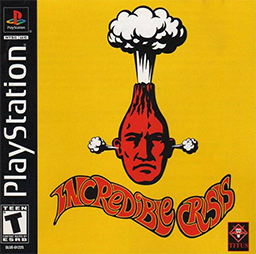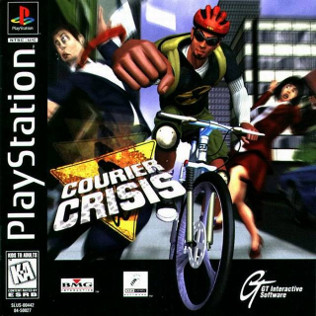
Time Crisis is a light gun shooter arcade game, developed and released by Namco in 1995, and the first title to be released in the series of the same name. The game differentiated itself from other light gun shooters of the time by incorporating a pedal that controls when the player character takes cover to reload and avoid enemy fire. Players have a limited amount of time to clear each section by defeating enemies. The game's story focuses on Richard Miller, a secret agent, who is sent to rescue a kidnapped woman from a ruthless tyrant seeking to reclaim control of their former country from a new regime.

Gauntlet Legends is an arcade game released in 1998 by Atari Games and Midway Games. It is a fantasy themed hack and slash styled dungeon crawl game, a sequel to 1985's popular Gauntlet and 1986's Gauntlet II and marks the final game in the series to be produced by Atari Games. Its unusual features for an arcade game included passwords and characters that could be saved, enabling players to play over the course of a long period.

Time Crisis II is a 1997 light gun arcade video game developed and published by Namco. It is the second instalment in the Time Crisis series. The game incorporates the same mechanics of its predecessor, with some minor changes, but with the addition of co-operative two-player gaming. The game's story focuses on the efforts of two secret agents, Keith Martin and Robert Baxter, as they attempt to thwart the efforts of an industry mogul's plan for world dominance.

Incredible Crisis, known in Japan as Tondemo Crisis!, is a PlayStation video game developed by Polygon Magic. The game was published in Japan by Tokuma Shoten on June 24, 1999. Translated versions were released by Titus Interactive in North America and Europe throughout November 2000.

Dino Crisis 2 is a 2000 action-adventure game developed by Capcom Production Studio 4 and published by Capcom for the PlayStation. It is the second installment in the Dino Crisis series, with designer Shu Takumi taking over as game director from Shinji Mikami from the first game. The narrative continues the story of special operative Regina, who must deal with the fallout of a time-distorting event which transports a research base and the surrounding area through time. Regina and team leader Dylan Morton must battle against dinosaurs in order to find a way to get back to the present.
Point Blank, known as Gun Bullet, or Gunvari in Japan, is a series of light gun shooter games developed by Namco for the arcade, PlayStation and Nintendo DS; the trilogy was first released in arcade in 1994 and was later ported onto the PlayStation. Point Blank DS was released in 2006 for the Nintendo DS featuring 40 challenges from the original series.

Resident Evil Survivor is a light gun shooter video game developed by Tose and published by Capcom. It was released on the PlayStation in Japan on January 27, 2000, in Europe on March 31, 2000, and in North America on August 30, 2000. It is a spin-off of the Resident Evil video game series. It is also the first first-person perspective Resident Evil game predating Resident Evil 7: Biohazard by seventeen years. A Microsoft Windows version was released only in China and Taiwan on September 7, 2002.

V-Rally 2 is a racing video game developed by Eden Studios and published by Infogrames for PlayStation, Dreamcast and Microsoft Windows. It was originally planned for release as a Nintendo 64 title, but was cancelled during the early development phases of the game and was never officially announced.

Hydro Thunder is an arcade inshore powerboat racing video game originally released by Midway Games in February 1999 and later released for the Sega Dreamcast as a launch title later that year. It was also released for the PlayStation and Nintendo 64 in early 2000. This game is part of Midway's Thunder series of racing games, which includes Offroad Thunder, 4 Wheel Thunder, and Arctic Thunder. Hydro Thunder Hurricane, a sequel to Hydro Thunder, was later released for the Xbox 360 on July 27, 2010 on Xbox Live Arcade.

RayForce is a vertically scrolling shooter by Taito for the Taito F3 arcade hardware and released in 1994. It was ported to the Sega Saturn in 1995, Microsoft Windows in 1997, then rereleased for iOS in 2012 and Android in 2017.

G-Darius is a horizontally scrolling shooter arcade video game released by Taito in 1997. It is the fourth arcade installment of the Darius series and the first with three-dimensional polygonal graphics. A port to the PlayStation was published as G Darius.

RayStorm is a 1996 vertically scrolling shooter arcade video game developed and published by Taito. It has been ported to several consoles, including the PlayStation, Sega Saturn, and Xbox 360. Players control a starship, the R-Gray, in its mission to destroy the Secilia Federation before it destroys Earth.

Capcom vs. SNK: Millennium Fight 2000, also known as simply Capcom vs. SNK in international releases, is a 2000 head-to-head fighting game produced by Capcom originally released as a coin-operated arcade game for Sega's NAOMI hardware and later ported to the Dreamcast. It is the second game in the SNK vs. Capcom series and the first game in the series to be released for the arcade.

NHL Open Ice: 2 on 2 Challenge is an ice hockey arcade video game released by Midway Games in 1995. It has been described as an ice hockey equivalent to Midway's NBA Jam.

Super Puzzle Bobble, released as Super Bust-A-Move in Europe and North America, is a puzzle video game in the Puzzle Bobble series. It was developed by Taito, and released on November 27, 2000 by Acclaim Entertainment for the PlayStation 2, and by CyberFront and EON Digital Entertainment for Windows in 2001. It was later ported to the Game Boy Advance that same year, the Japanese version under the name Super Puzzle Bobble Advance. It was re-released in Japan for the PlayStation 2 in 2004 as part of Super Puzzle Bobble DX, which is Volume 62 of the Japan-exclusive Simple 2000 Series. This compilation includes a few graphical enhancements.

Centipede is a 1998 action game developed by Leaping Lizard Software, and a remake of Atari's 1981 arcade game of the same name. It was published by Hasbro Interactive, their first under the Atari label after purchasing the brand and former assets.
The GunCon, known as the G-Con in Europe, is a family of gun peripherals designed by Namco for the PlayStation consoles. The original controllers used traditional light gun technology, while newer controllers use LED tracking technology.

JoJo's Bizarre Adventure is a fighting video game developed by Capcom based on Hirohiko Araki's manga of the same title. The game was developed by the same team who was responsible for the Street Fighter III series.

Road Rash: Jailbreak is a racing video game developed by EA Redwood Shores for the PlayStation and Magic Pockets for the Game Boy Advance, and published by Electronic Arts for PlayStation in 2000 and for Game Boy Advance in 2003. It is the sixth and final game in the Road Rash series.

Courier Crisis is an action video game developed by American studio New Level Software for PlayStation and Sega Saturn in 1997.



















